When Lillian Schwartz made the decision in 1968 to employ computers to create art, she was required to enter a field with arguably the strongest masculine culture—engineering. Therefore, we expect Schwartz’s experience to be a negative one, reflecting the institutionalized sexism that engineering was notorious for. Yet we find the opposite to be the case. The artist found early computing to be devoid of gender bias. Using this simple paradox as my starting point, my essay explores the role of gender in the formation of digital art. Informed by personal reflection and anecdote, this case study reveals women artists as key agents in the development and propagation of digital art in the United States.1 Although their art is varied in form and focus and each started at different moments, these pioneering artists, including Lillian Schwartz, Collette Bangert, Joan Truckenbrod, Grace Hertlein, Rebecca Allen, Copper Giloth, Barbara Nessim, and Cynthia Rubin, shared similar experiences. Compared to the patriarchal power structure that defined the mainstream artworld, these women found the emergent field of computing to be relatively open. In those formative years social norms proved to be more fluid and gender barriers remained unconstructed, even though computing would masculinize soon after. In its infancy, digital art was, as artist and writer Anne M. Spalter enthusiastically put it, “up for grabs.”
But how did women artists overcome the fallacy that computer technology was inherently masculine? And why did computing become a kind of sanctuary for some women artists? I will show that the indeterminacy and flux that permitted freer agency, was reflected in the computing field as a whole. During the late 1960s, computer science went through a rapid process of expansion and professionalization, and the visual sphere of computing, computer graphics, was in its developmental stage. A number of distinctive research laboratories arose, and though they reflected the increasing androcentric character of computing, they were decidedly more inclusive, searching for the most creative minds regardless of gender. Other larger cultural and political shifts also impacted female participation. The second-wave of feminism produced many desirable outcomes, including gender equality laws, which influenced male-dominated occupations, and education reform, which broadened opportunities for women in both science and art. By no means, however, was the formation of digital art seamless. As many of the artists will attest, an enduring gender-neutral space was elusive. Doors that were once open to women in the first years soon closed. And while women were able to define what was then called “computer art” outside the parameters of male hegemony, the computer was actively shunned by the orthodox artworld. For traditional artists and critics, computer art, with its reliance of techno-science discourse, was antithetical to most artworld ideals. Over time, this anti-computer sentiment, which affected all artists using the medium, would prove so pervasive that it often eclipsed the sexism later suffered by women.
The impact of women in the formation of early digital art has been largely ignored. Underlying this lack of scholarship is a double predisposition: firstly, the view that women played an insignificant role in the development of digital technology, and secondly, that ‘computer art’ is inconsequential to normative art historiography. Recently, however, perceived imbalances have led historians from a variety of disciplines to uncover, what professor of sociology Judy Wacjman aptly described as the “hidden” history of women in early computing.2 As recent research has shown, women’s contributions are often minimized or ignored as technology is historicized through masculine discourse.3 Current historical research has revealed much of what was obscured, placing visionary computer programmers, such as Rear Admiral Grace Murray Hopper, in full context. 4 Reaching farther back into history, various disciplinary perspectives have now been written on the 19th-century mathematician, Augusta Ada King, Countess of Lovelace, whose seminal role in programming the first mechanical computer has elevated her to an almost mythical place in the chronicle of computing. As this new research emerged—acting as a counterforce to prevailing masculinist narratives—woman artists also began telling their story. In 1993, the journal Leonardo began the Women, Art, and Technology Project as a way to “encourage women artists working with technology-based media to write about their work.”5 Such initiatives proved successful and publications followed. For instance, Judy Mallory’s edited book, Women, Art, and Technology (2003), gave evidence of a “strong, influential, central female presence in the field of new media,” even in the face of “continuing male domination of the computer industry.”6
While these published accounts are welcomed, we find emphasis is weighted toward contemporary artists, thus effectively leaving the cultural context of early women artists largely unexplored. This oversight has meant authors predictably posit Collette Bangert in 1967 and Lillian Schwartz in 1968 as the first women to employ the computer to generate art. In actual fact, the first women involved in computer-generated art were not Bangert and Schwartz, but more likely women programmers working a half a decade earlier at the Army Ballistic Research Laboratories (BRL) in Aberdeen, Maryland. Uncovering the forgotten history of the first “award winning” example of computer art gives us insight into both the militaristic origins of digital art as well as how computer programming, commonly perceived as androcentric today, was originally a highly feminized occupation.
The trade journal Computers and Automation facilitated the birth of computer art through its “Computer Art Contest” in 1963. That year, the first and second prizes went to the BRL, a site synonymous with the computing revolution during and after the Second World War. BRL had produced the first general-purpose electronic computer, the famous ENIAC, which was followed by ever more powerful computers, such as the ORDVAC, EDVAC and the BRLESC 1. The prize winning art piece, Splatter Diagram, which was a design analogue of the radial and tangential distortions of a camera lens, would have been computed on one of the later machines.
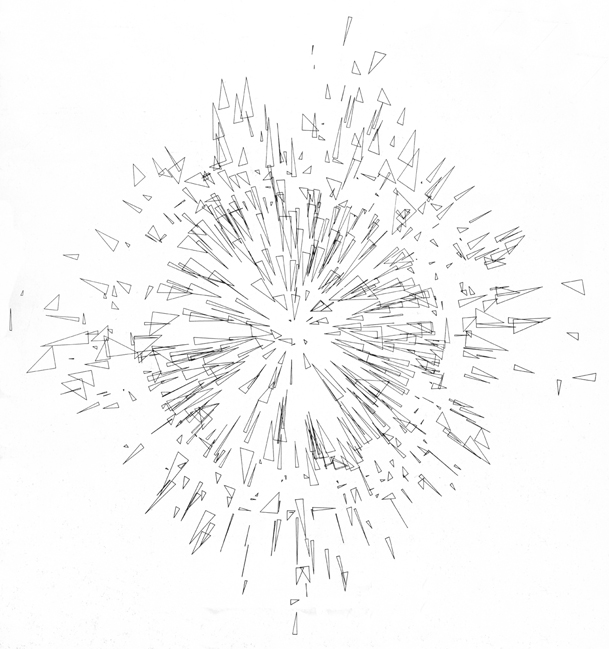
In 1964, the same laboratory won first prize again for an image produced from the plotted trajectories of a ricocheting projectile. The original images, which now appear to be lost, were not attributed to a particular person, being largely collaborative efforts and byproducts of ballistics visualizations. Nevertheless, by investigating the history of computing at BRL, we can be sure women played a part in this milestone in digital art history.
Women were seminal in the development of the electronic computer.7 Even prior to the Second World War, women were responsible for manually calculating complex firing tables required for ballistic weaponry—they were in effect “human computers.” At BRL, large groups of women were required to calculate tables around the clock. Following the War, the best ‘computers’ were recruited by male engineers to code the first modern electronic computer, the ENIAC, which was a direct descendant of the computer used in the creation of the first computer artworks. The “ENIAC girls,” as they are now popularly called, are widely celebrated as the “world’s earliest computer programmers,”8 and would provide the model for female involvement in future groundbreaking ballistics visualization at BRL.
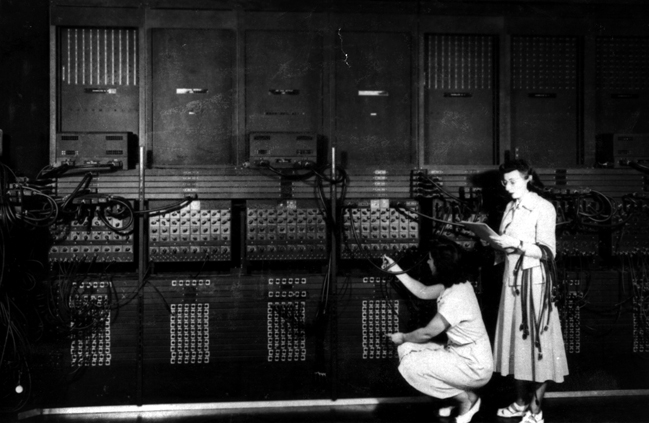
By the time trained women artists entered the field in the late 1960s, the terrain of computing was becoming increasingly masculine. Since the 1940s, programming had been largely a female occupation. Mimicking the mechanical operation of the telephone switchboard, the programmer possessed the long-standing gendered overtones of clerical work. The male engineer, conversely, was the “planner” whose role was deemed more analytical. In the professional hierarchy, the male was associated with technical mastery and intellectual analysis, while the female role of programmer was associated with rudimentary manual labor, even if the business of programming was a highly demanding ability, requiring various creative and analytical skills.9 In the late 1960s, however, programming would become stereotypically a masculine endeavor, making the profession, as historian Nathan Ensmenger writes, “inhospitable to all but the most adventurous and unconventional women.”10 Today’s “computer geek,” characterized as highly idiosyncratic, frequently unkempt, socially detached, and fiercely non-conformist, developed from this gendered archetype. Early women artists were acutely aware that computing was being culturally constructed as masculine. Sue Gollifer, who looked at computing as a possible path in the early 1970s, was hesitant to enter, sensing the prevailing male paradigm, and Rebecca Allen, while lamenting the inherent maleness of all professional fields, perceived computing as “hyper-male.”
Incongruent as it may seem, the computer industry was still remarkably accepting of women, even as it went through a process of masculinization.11 In 1967, Cosmopolitan magazine published an article, entitled “The Computer Girls,” that signaled larger cultural changes. Though appearing often trivial and sexist to contemporary readers, the article captured the spirit of the computer revolution as it appeared to women in the field. The article announced the “unlimited” opportunities within computing, an industry going through rapid expansion and a subsequent labor shortage. The author confidently announced that “sex discrimination in hiring” was practically nonexistent, boldly stating that if the woman was “qualified, she’s got the job.”12 One of the woman programmers profiled in the article, Helene Carson, felt she was “fully accepted as a professional,” a recognition she had not received in traditional sciences.13 The assertions in the article proved to be true. Some of the normal barriers to female participation were absent. This upward mobility was evidenced in 1969 when Rear Admiral Grace Hopper, who was also quoted in the Cosmopolitan article as a female expert, was awarded, ironically, a prestigious “man of the year” award for service to computer science. In this time of rapid expansion, the computer industry, in conjunction with leading research universities, were remarkably receptive to female involvement, subsidizing many of those early programming courses taken by women artists.
While the door was open for women to enter the industry, women artists were more attracted to what Rebecca Allen described as the “leading edge” of the digital frontier. Rather than join the commercial and business sector of computing, a sphere where women programmers were in such high demand, women artists entered at the point where advanced research was conducted. Women artists found themselves at university research centers, such MIT, NYIT, Brown University, and the University of Illinois, while others started at corporate settings, such as Bell Labs, TIME Corp, and 3M. Joan Truckenbrod felt that although computing was a “gendered milieu,” and that a woman was necessarily an “outsider,” being at the center of an emerging technology was “liberating.” At this leading edge, computing was far less defined, highly experimental, and less prone to the stifling weight of institutionalization. Moreover, during the last years of the 1960s, computer science was only just emerging as a legitimate scientific field. With the publication in 1968 of Donald Knuth’s canonical text, The Art of Computer Programming, computer science now had a substantive history and a solid theoretical foundation. New journals, societies, and standardized education followed, completing the process of professionalization. Even though women artists were entering the computing at its determinative stage, the area of their artistic focus was an even less developed subfield of computer science—computer graphics and animation. Where computer science traces its lineage back to the 1940s, computer graphics was a child of the 1960s. In 1960, William Fetter, an engineer from Boeing, coined the term computer graphics, and through that decade, various corporate and university laboratories created revolutionary visual technologies, including, at the close of the decade, the Graphic User Interface (GUI). During the late 1960s, the special interest group dedicated to graphics research, SIGGRAPH, would form and eventually become, under the leadership of women artists, an avid supporter of computer art.
While a lack of clear disciplinary boundaries across computing aided women artists, larger social and political changes also augmented self-determination. In the early 1970s, during a highly successful period in the history of second-wave feminism, the Equal Employment Opportunity Act and Title IX of the Education Amendments passed, which outlawed sex discrimination in the workplace and educational settings. In addition, federally mandated affirmative action had an impact on those technology sectors that relied on government contracts.14 In the period from 1968 to 1972 women scientists and engineers, who had endured years of discrimination, began to talk about “fairness and the need for change.”15 New industry groups, such as the American Society of Engineering Education, formed task forces to examine gender issues in the discipline. As a result of this cultural reflexivity, the percentage of engineering students who were women increased exponentially. With a corresponding growth of women in computer science, The Association for Women in Computing (AWC) was founded in 1978.
Similar gains were felt in those creative fields once dominated by men; for example, a generation of women science-fiction writers came to prominence.16 In the visual arts, the feminist movement brought about immediate and wide-ranging effects, including landmark exhibitions, fresh critical perspectives, and new activist organizations.17 In the area of praxis, some feminist artists chose to cease painting, considering the medium, with its elevated position in the Western art canon, as too masculinist. Non-mainstream media, such as textiles, video, and the body (performance), became appropriate alternatives. Anne Spalter suggests that women were attracted to the computer for similar reasons; because “unlike traditional fine art media, [the computer] does not have a history of primarily male practitioners.”18 Contrasting strongly to other avant-garde movements of the period, such as Minimalism, computer art had an absence of any rarefied canon of masters or aggrandized biographies of male practitioners.19 But while the computer lacked the masculine import of other media, it was not widely used as a feminist tool, as was the case with video. Unlike their feminist contemporaries who challenged cultural norms, early computer artists—male or female—did not reflect an overt interest in polemics. When Schwartz entered Bell Labs, she was not actively seeking equal rights within the male domain. It was not until the 1980s that women dealt directly with gender issues. Even when Copper Giloth in the 1980s approached the controversial topic of abortion in her installation Clothes Hangers, she found her peers in the computer art movement to be “uncomfortable,” preferring instead to avoid highly politicized topics.
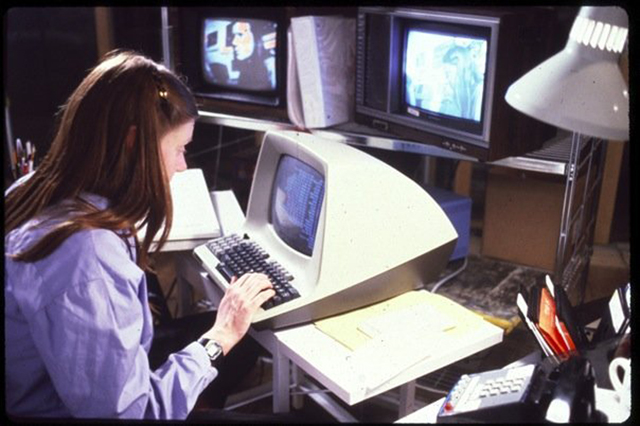
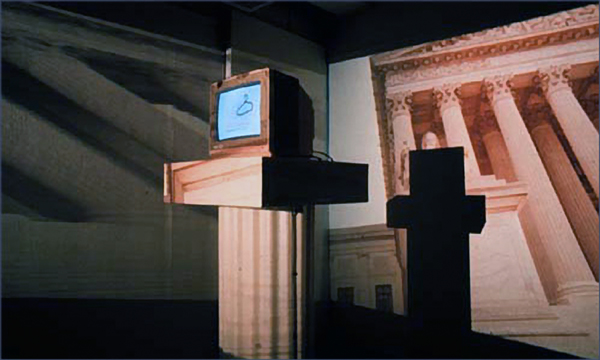
In another landmark moment in digital art history, Allen, who had been interested in the implications of bodily movement, a topic common to feminist theorists of the period, created The Catherine Wheel, the first ever publicly broadcasted 3-D computer-generated character to mimic human motion. Allen was gratified that this historic character was female.
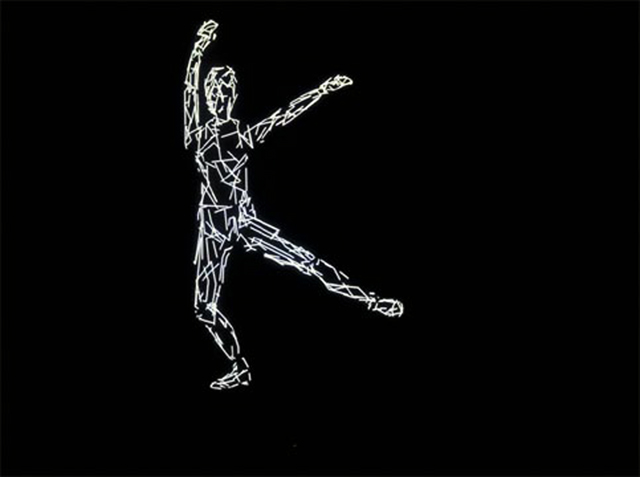
Perhaps one of the reasons why early digital art was largely apolitical was that producing art with early computers was exceedingly difficult—getting the machine to function correctly was seen as a major success. It took a certain type of artist—inquisitive persistent, and insightful—who could commit to the ever-changing technical demands. Common to pioneers was a vision, or “intuition” as Truckenbrod described it, that computers would fundamentally change art. This desire to be at the forefront of this new digital age is what led Schwartz to Bell Labs.
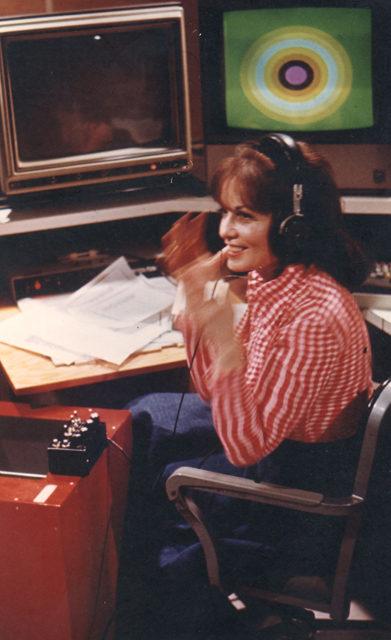
She was part of a larger cultural movement in the late 1960s that attempted to marry—often with acrimonious outcomes—the worlds of art and technology. The Art and Technology movement, as it became called, was a conscious effort to foster collaboration between artists and large private and government institutions, such as AT&T and IBM. In 1966, the movement gained traction when avant-garde artist, Robert Rauschenberg, joined with Bell Labs physicist, Billy Klüver, to stage Nine Evenings: Theatre and Engineering. This watershed event was soon followed by the founding of Experiments in Art and Technology (E.A.T.), an organization Schwartz joined. Following Schwartz’s inclusion in the 1968 epoch defining exhibition, The Machine: As Seen at the End of the Mechanical Age, she was invited to Bell Labs, where she stayed for much of her career.
The Art and Technology movement was part of a larger desire to bridge what appeared to be two increasingly divergent worlds of art and science. Without these various collaborative initiatives of the 1960s, like the one at Bell Labs, artists would not have had access to computers. And even when artists gained access to computer labs, it was usually at nights and weekends, times when the computer was not in official use. These laboratories required an expansive vision, one that valued open-ended exploration over short-term commercial application. Bell Labs was that type of unique institution, a “place of misty legend” as Knowlton describes it, where engineers were free to explore without the burden of immediate commercial application.20 Under the energetic leadership of John R. Pierce, engineers and artists took a variety of art forms—graphics, music, choreography, film, and animation—and exposed them to the new powers of digitization. Bell Labs’success created a collaborative model that other research institutions followed. When Rebecca Allen went to MIT’s Architecture Machine Group, which was male-dominated like Bell Labs, it was her intelligence and creative drive that gained her acceptance. She sensed an attitude that if you “were smart, you would be accepted.” In this environment, innovative thinking gave someone credibility; it meant a woman could “get into the club.” Likewise, when Giloth completed graduate research at the Electronic Visualization Laboratory (EVL) at the University of Illinois, Chicago, which was founded in 1973 by Tomas DeFanti and Daniel Sandin, she received a “good reception.” Being a genuine interdisciplinary program, the all-male faculty were more attracted to her training in sculpture and her ambitious and exploratory ideas than her gender. For both these women, they felt they were judged on how effectively they could contribute to the process of invention. As Grace Hertlein recollected, “we were equal and what mattered was the work.” The women artists often felt a collaborative spirit that connected them to their male counterparts—a thin line that fastened them together on what Allen recalls as the “scary edge” of advanced technology.
Although these cutting-edge research environments were inclusive, seeking the most creative minds regardless of gender, it is important to recognize that even at these progressive intuitions, true gender equality was elusive. The “boys’ clubhouse” mentality in computing has been well documented,21 and artists, like Allen, felt the “unspoken assumptions” of the field and the “passive rituals and longstanding hierarchies” of the lab environment. Allen felt that if she was to be successful, she would need to conform and adapt. At MIT, Allen was entering a field with few women, and being an artist made her even more exotic. Being both was an obvious challenge. And even though Schwartz found gender to be a trouble-free issue at Bell Labs, the first celebrated computer artwork to be produced at the famed Lab was the result of a decidedly male styled “sophomoric prank.”22 Taking place a few years before Schwartz’s arrival, the event nonetheless illustrates the masculinist culture of computer engineering at that time. When Knowlton learned that his engineering colleague, Leon Harmon, was going to be absent from the building, he generated a large nude image to cover his colleague’s office wall.
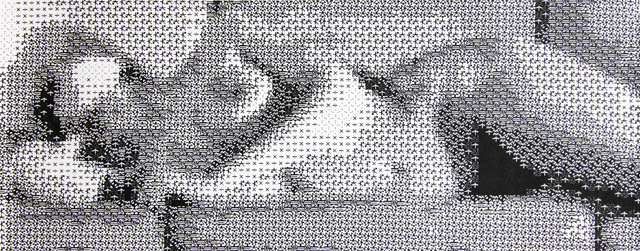
Middle management, nervous about the risqué image, asked for it to be taken down. Sometime later, however, it was employed at Robert Rauschenberg’s loft as a backdrop to an Art and Technology press conference, and then later the image appeared in the New York Times. Once nervous about displaying the nude, Bell Labs, sensing the popularity of the image, now made certain that it was accredited to the AT&T Corporation. Knowlton, delighted that his prank had made it to the “venerable Times” and thus making a cultural transition from “frivolous in-your-face pornography” to “in-your-face Art,” proceeded to give the nude the more “dignified title” it carries today.23
While women artists had to endure unwelcome masculine behaviors in the vanguard of computing, those experiences were often minor compared to the highly gendered impasses found in the artworld. What made the artworld even more forbidding were the responses to the computer itself, which ranged from deep suspicion to total indifference. Computer artists discovered early, as Allen reminisced, that “the artworld was against anything using a computer.” Barbara Nessim, who had gained access to computers at TIME Corporation, was flabbergasted when she invited fellow artists to work digitally, only to find them hastily reject the invitation. Grace Hertlein remembers vividly being mocked and insulted by traditional artists. Some in the arts were uncomfortable with the fact that the computer had technocratic and militaristic origins, deeming it to be part of the dehumanizing tendencies of the military-industrial complex.24 Other critics were more dismissive, viewing computer art as just another example of the vulgarization of science, where besotted artists, flirting with the latest scientific and technological media, produced what was tantamount to science as kitsch.25 As students, women artists were actively discouraged from pursuing computing as a possible art-making path. While some galleries showed computer art, these exhibitions were often “condescendingly reviewed,” as though the medium was “without serious intent or noble aspiration.”26 In fact, there is a litany of stories that tell how computer art had been accepted on its merits only to be rejected once the curators discovered it was produced with the use of the computer. Most computer artists were castigated and insulted by the mainstream art galleries.27 Such was the stigma attached to computers that artists have used the expression “kiss of death” to describe the act of using computers in art.28 As a result, the term “computer art” was so thoroughly denigrated that its usage declined in the 1990s, eventually being replaced by the more expansive descriptor: “digital art.”
Because the “door to the artworld was closed,” as Allen explained, artists were required to “seek other venues” to show their digital art. Allen and Schwartz expanded into other media forms, showing their artwork on public and cable television networks, which resulted in both receiving Emmys.
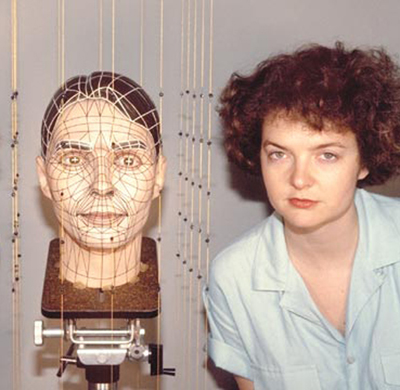
Securing an ongoing exhibition was finally achieved by Darcy Gerbarg and Copper Giloth who organized the first art exhibitions in conjunction with the SIGGRAPH conference. Curated by Gerbarg, the inaugural 1981 exhibition included Lillian Schwartz, Joan Truckenbrod, Ruth Leavitt, Copper Giloth and Colette Bangert. Giloth would curate the following two annual SIGGRAPH exhibitions, with the 1983 “Exhibition of Computer Art” becoming a highly successful international show.29 While the first exhibition was a modest affair, existing as a minor sideshow to the latest research presentations, it allowed artists to develop the esprit de corps of a relatively coherent group. From the perspective of the mainstream artworld, however, the developing community appeared, as Allen wryly described it, as the “computer art ghetto.” Although other international groups emerged and provided new exhibition spaces, such as Ars Electronica in Linz Austria and ISEA founded in the Netherlands, segregation from the orthodox artworld continued to plague digital artists. Beyond becoming a kind of Salon des Refusés for digital artists, these organizations continued to play a crucial supportive role, one in which a confederate of like-minded artists could share their abiding interests in emergent technology. Eventually, however, those institutions, along with the digital arts as a whole, emerged as a microcosm of the larger artworld, reflecting similar hierarchical structures and modes of exclusivity.
Gerbarg and Giloth’s leadership and vision was part of a longer tradition of women shaping digital arts. Women emerged as primary agents in the theorization and criticism of computer art as early as the late 1960s. In 1968, Jasia Reichardt curated arguably the most important exhibition of early digital art, Cybernetic Serendipity—The Computer and the Arts, at the Institute of Contemporary Arts, London. This bold curatorial experiment initiated much of the worldwide interest in computer art and provided a template for future multimedia art exhibitions. Reichardt followed with two influential publications, The Computer in Art (1971) and Cybernetics, Art and Ideas (1971), which marked her as the most astute commentator of the computer art phenomenon. Other women voices were heard during the period. Grace Hertlein wrote extensively on computer art, founding the magazine Computer Graphics and Art, and Ruth Leavitt gave voice to a range of computer artists in her seminal book Computer and Artist (1976). In addition, the visionary writings of Lillian Schwartz, Vera Molnar, and Collette Bangert shaped computer art discourse, creating the foundation for the next generation of writers, who included Cynthia Goodman, Margaret Lovejoy, Patric Prince, and Anne M. Spalter.
But perhaps where women artists were most transformative was through their innovative approach to the medium. Early computer art was dominated by geometric abstraction, and male technologists and artists were quick to trace their hard-edge, linear aesthetic back to early abstract modernist movements, such as Constructivism. Women were crucial in shifting computer art away from the cool rhetoric of mechanical abstraction, toward styles informed by the organic and the human. 30 For example, in the early 1970s, Grace Hertlein completed the naturalistic work The Field, which employs traditional drawing mediums such as paper, pens, and inks to produce more biological effects.
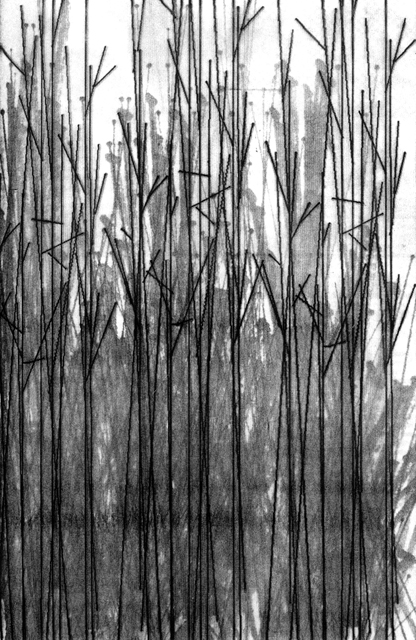
Women artists deliberately subverted the precision and symmetry of the computer, pushing their practice towards inexactness and disorder. Bangert, who sought to humanize the computer, produced landscapes with her husband that simulate expressionistic strokes of the human hand.
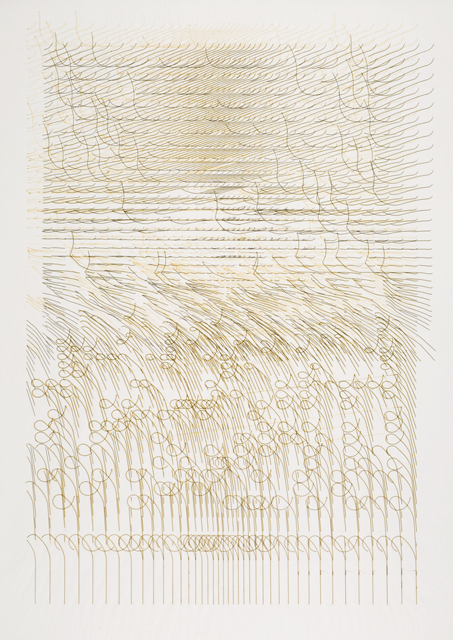
Though not conscious of it at the time, the naturalizing tendencies undertaken by computer artists mirrored the intentions of many feminist artists of the period, who took ownership over those gender stereotypes deemed feminine. In response to the disembodied, masculinized abstraction of late modernist movements, feminists celebrated the physicality of the body and the subjectivity of personhood.31
However, women did not merely introduce tactile and natural form into computer aesthetics; they tested the very boundaries of the digital art object. In the first decade, most artists and theorists defined computer art in terms of the paradigm of the “artist-programmer,” who worked at mathematically configured spatial form, pattern, and structure, which conformed to established norms of static, pictorial art. Schwartz and Truckenbrod effectively ignored computer art’s modernist impulse to rigorously delimit and define the new art form. From the very beginning, these women artists were interested in the sensual, interactive, and synesthetic aspects of digital creation. The idea of the computer as an “expanded medium” had been implicit in Schwartz’s practice since the late 1960s.32 By integrating both digital and analogue media, traditional practice and advanced technology, Schwartz employed the computer as a polymorph of tools. Digital production was not just a cerebral exercise, widely accepted by those artists who viewed “programming” as the true art form, but as a full sensory experience. Seeing the computer as a consortium of tools that mimic traditional media, Schwartz foresaw the screen-based, multifaceted digital arts practice that emerged in the late 1980s. Sharing the language common to avant-garde artists of the era, though operating on the peripheries, early women artists desired to “disrupt,” “push,” “subvert,” and “reconfigure” digital technology.
While the first women found unprecedented success in expanding and theorizing digital art, perhaps their most enduring legacy is in the field of education. Most acted as the first educators to teach digital forms of art, while others built the first digital art and new media programs in the United States, and thus introduced a new generation of women to digital arts. Lillian Schwartz became a goodwill ambassador for the United States Information Agency (USIA), lecturing on computers and art around the globe. Sonia Landy Sheridan started the highly innovative Generative Systems Department at The School of the Art Institute of Chicago and Joan Truckenbrod was instrumental in bringing computer arts to Northern Illinois University and building the Art and Technology program at The School of the Art Institute of Chicago. Rebecca Allen, was the founding co-director of UCLA’s Center for the Digital Arts, and later the founding chair of Design | Media Arts at the same institution. Copper Giloth developed undergraduate and graduate programs in Computer Art at the University of Massachusetts, Grace Hertlein started computer arts at Chico State University, and Barbara Nessim was instrumental in bringing computing to the Parsons School of Design. However, founding these digital art programs was not without difficulty. While traditionalists soon realized that digital media was going to significantly shape future art, all the women artists received significant pushback from suspicious art departments. For Giloth, the deeply patriarchal male colleagues in the department found advanced technical expertise intimidating—especially when it “came from a woman.” Unfortunately, while the feminist movement led to more equality and opportunity for women, the masculine nature of engineering, computer science, and the visual arts remained largely intact. The recent falling enrollment and the exodus of women from computer science has shown the depth of the problem.33 In the arts, Cynthia Rubin believed that digital art “liberated” her from “the prejudice” she faced when she was a woman painter, but then when the computer became more widespread, the “old prejudices” returned.34 Allen is also ambivalent too, admitting that after thirty years in computing, she is “disappointed at how little has changed.” Being the “only women in the room” and having to “adjust” to male dominance has its cumulative effects. This despondency, which has led to Allen contemplating abandoning her extraordinary career in technology, is shared by other women in computing. 35 Nevertheless, Allen remains optimistic that a new generation of influential women practitioners will emerge. Yet, she warns, those character traits that defined pioneering women artists—determination, tenacity, and a forceful intellect—will remain necessary prerequisites.
[This article was originally published at http://lateral.culturalstudiesassociation.org/issue2/theory/taylor/index.html. A PDF the original version has been archived at https://archive.org/details/Lateral2.]
Notes
- All artist quotations, unless specified, are recorded from these interviews: Lillian Schwartz, e-mail message to author, May 25, 2004 and December 16, 2011. Anne Spalter, e-mail message to author, January 20, 2005. Sue Gollifer, e-mail message to author, June 1, 2004. Rebecca Allen, interview by author, November 21, 2011. Joan Truckenbrod, e-mail message to author, November 28, 2012. Copper Giloth, interview by author, November 20, 2011. Barbara Nessim, interview by author, November 21, 2011. Grace Hertlein interview by author, December 15, 2011. ↩
- Judy Wajcman, “Reflections on Gender and Technology Studies,” Social Studies of Science, Vol. 30, no.3, (2000): 447. ↩
- Jennifer S. Light, “When Computers Were Women,” Technology & Culture, Vol. 40, no. 3 (1999): 455–483. ↩
- Kurt Beyer, Grace Hopper and the Invention of the Information Age (Cambridge, Massachusetts: The MIT Press, 2009). ↩
- Patricia Bentson, “Foreword: The Leonardo Women, Art, and Technology Project,” in Women, Art, and Technology, ed. Judy Malloy. (Cambridge, Massachusetts: The MIT Press, 2003), xii. ↩
- Judy Malloy, preface to, Women, Art, and Technology, ed. Judy Malloy (Cambridge, Massachusetts: The MIT Press, 2003), xv. ↩
- Nathan Ensmenger, “Making Programming Masculine,” in Gender Codes: Why Women Are Leaving Computing, ed. Thomas J. Misa, (Hoboken, New Jersey: Wiley, 2010), 120. ↩
- Nathan Ensmenger, The Computer Boys Take Over: Computers, Programmers, and the Politics of Technical Expertise (Cambridge, Massachusetts: The MIT Press, 2010), 14. ↩
- David Alan Grier, “The ENIAC, the Verb “to program” and the Emergence of Digital Computers,” Annals of the History of Computing, Vol. 18, no. 1, (1996): 51–55. ↩
- Ensmenger, “Making Programming Masculine,” 116. ↩
- Ensmenger, The Computer Boys Take Over, 12. ↩
- Lois Mandel, “The Computer Girls,” Cosmopolitan (April 1976): 52–56. ↩
- Mandel, “The Computer Girls,” 51. ↩
- Pamela E. Mack, “What Difference Has Feminism Made to Engineering in the Twentieth Century?,” in Feminism in Twentieth-Century Science, Technology, and Medicine, ed. Creager, Lundeck, and Schiebinger (Chicago: The University of Chicago Press, 2001), 157. ↩
- Mack, “What Difference Has Feminism Made,” 156. ↩
- Charlie Gere, Digital Culture (London: Reaktion Books, 2002), 163. ↩
- Lawrence Alloway, “Women’s Art in the ’70s,” Art in America May–June (1976). ↩
- Anne Spalter, The Computer in the Visual Arts (Reading, Massachusetts: Addison-Wesley, 1999), 11. ↩
- Anna C. Chave, “Minimalism and Biography” in Reclaiming Female Agency: Feminist Art History After Postmodernism, ed. Nora Broude and Mary D. Garrard (Berkeley: University of California Press, 2005). ↩
- Ken Knowlton, “Portrait of the Artist as a Young Scientist,” YLEM Journal, Jan/Feb, Vol. 25, no. 2 (2005), 8. ↩
- Jane Margolis and Allan Fisher, Unlocking the Clubhouse: Women in Computing (Cambridge, Massachusetts, The MIT Press, 2003). ↩
- Knowlton, “Portrait of the Artist,” 10. ↩
- Knowlton, “Portrait of the Artist,” 10. ↩
- Grant D. Taylor, “The Machine that Made Science Art: The Troubled History of Computer Art, 1963-1989” (PhD diss., University of Western Australia, 2005). ↩
- Dieter Daniels, “Art and Media”, in The Age of Modernism: Art in the 20th Century, eds. C. M. Joachimides and N. Rosenthal (New York: DAP Publishers, 1997), 560. ↩
- Philip J. Davis and Reuben Hersh, Descartes’ Dream: The World According to Mathematics (Sussex: The Harvester Press, 1986), 48. ↩
- Paul Brown, “New Media: An Emergent Paradigm,” Periphery, 29 (1996): 13–15. ↩
- Brown, “New Media: An Emergent Paradigm,” 13. ↩
- Patric D. Prince, “A Brief History of SIGGRAPH Art Exhibitions: Brave New Worlds,” Leonardo, Supplemental Issue, (1989); 3–5. ↩
- Grant Taylor, “Humanizing the Machine: Women Artists and the Shifting Praxis and Criticism in Computer Art,” in The Journal of the International Digital Media and Arts Association, Vol 4, No. 2, (2007). ↩
- Laura Cottingham, Seeing Through the Seventies: Essays on Feminism and Art (Amsterdam: G&B Arts, 2000). ↩
- Lillian Schwartz and Laurens Schwartz, The Computer Artist’s Handbook (New York: W. W. Norton & Company, 1992). ↩
- Thomas J. Misa, “Gender Codes: Defining the Problem,” in Gender Codes: Why Women Are Leaving Computing, ed. Thomas J. Misa, (Hoboken, New Jersey: Wiley, 2010), 5. ↩
- Judy Malloy, Preface to Women, Art, and Technology, xv. ↩
- Margolis and Fisher, Unlocking the Clubhouse, 90–91. ↩